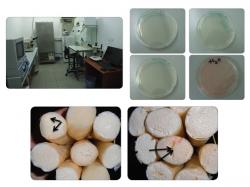StePac Developing A New Program, Focusing On Microbiology & Phytopathology
May 27, 2013 | 1 min to read

During the last couple of years StePac has been developing a new program, focusing on Microbiology and Phytopathology. The program, headed by Dr. Nadav Nitzan and integrated in the R&D unit, is aimed at: i) centralizing postharvest disease control information, ii) evaluating means for control of diseases caused by molds, yeasts and bacteria; and iii) identifying new, innovative solutions that together bring added value to StePac’s customers by complementing Xtend packaging and further reduce the risk of decay of produce packed within. In addition, the program is intended to provide customers with technical assistance and expertise in all areas of plant disease control and food microbiology. To achieve these goals, a specialized laboratory (Fig. 1), equipped with all necessary appliances, was established as part of the Post-Harvest and Polymer Technology Laboratory at StePac’s headquarters in Tefen, Israel.
A recent study conducted as part of the program focused on identifying solutions to control the pink contamination phenomenon identified on the bottom of white asparagus spears (Fig. 2). The cause of the phenomenon was diagnosed as Rhodotorula minuta, a pink colored budding yeast, which is prevalent in soils and in the environment. In a series of in vitro tests, commercially available sanitizers and food preservatives were examined for their efficacy to eradicate the contaminant yeast. Aliquots containing yeast cells were incubated for 5 minutes with each of the tested sanitizer or food preservatives. Of the various compounds tested, three commercial sanitizers eradicated the yeast at concentrations of 80 – 100 ppm (Fig.3). The encouraging in vitro results are already being utilized commercially to control pink butt contamination on white asparagus.
Source: StePac
